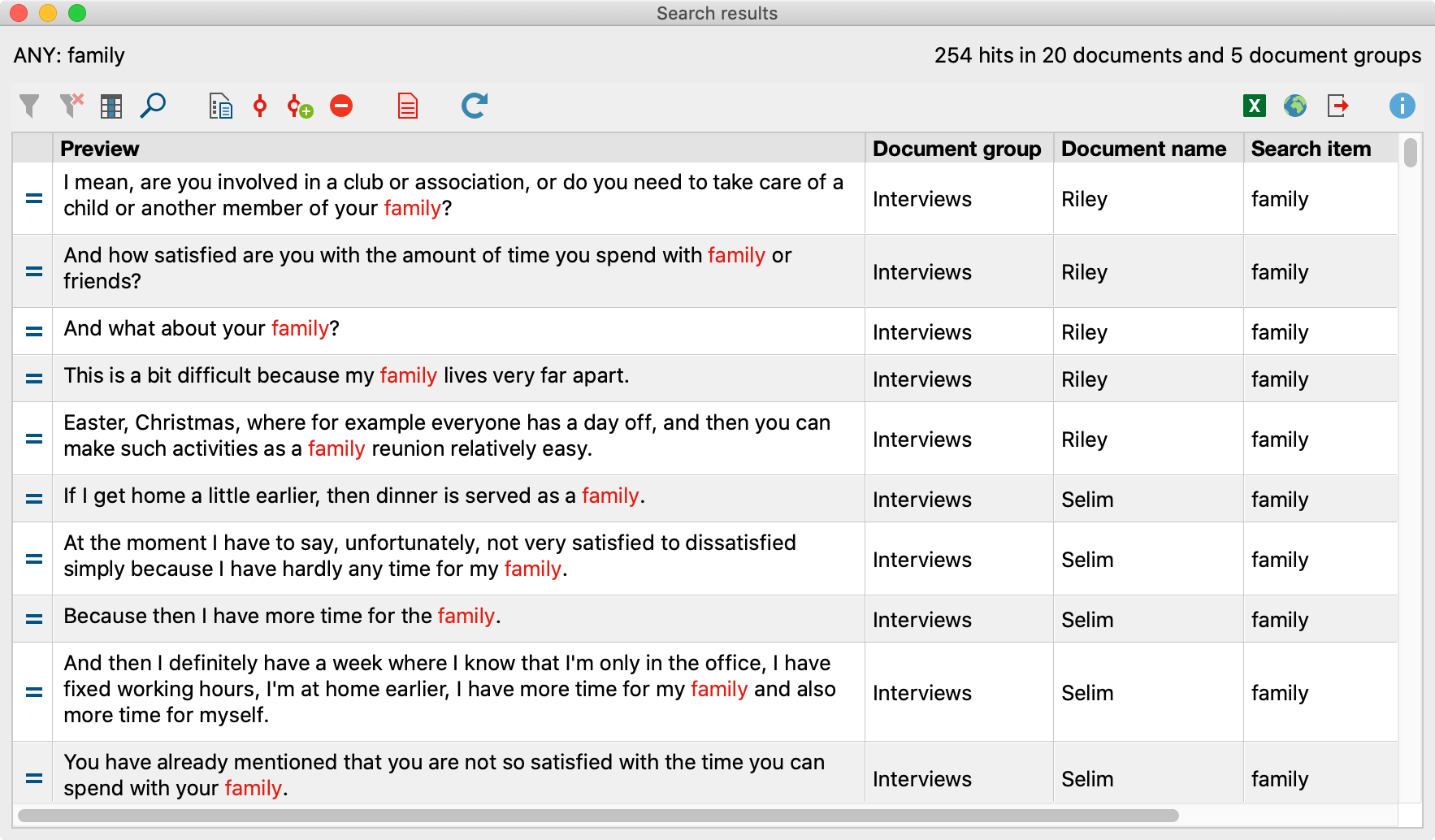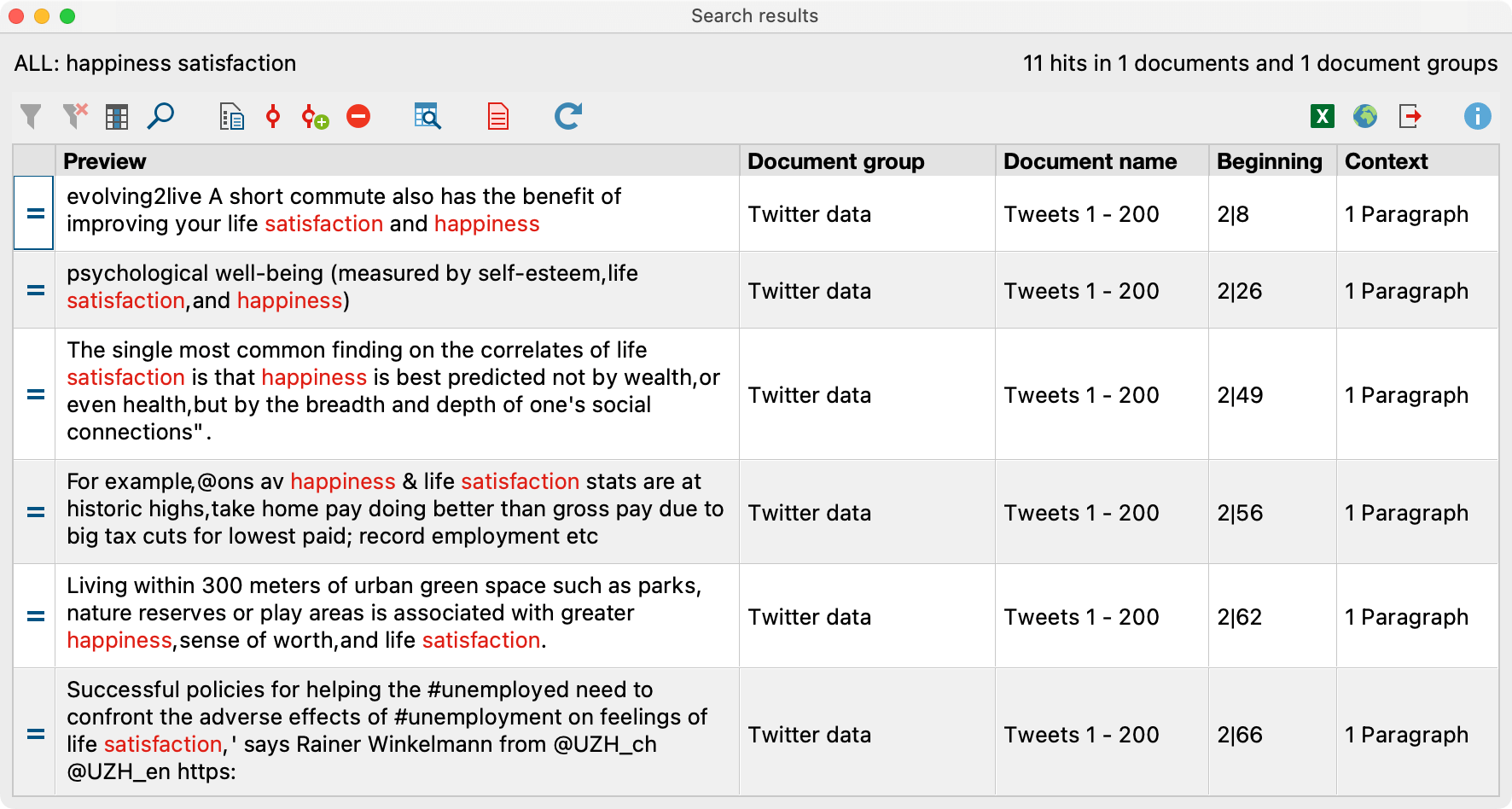Your results of a search within documents will be shown in a table that appears as follows:

At the top right, you can see the number of search hits and from how many documents and document groups they originate.
Along with the usual filter functions, the toolbar at the top of the results window provides access to the following functions:
![]() Save number of hits per document as document variable – Adds a new document variable that contains the number of hits for each document. The variable for further analysis can be used for further analysis.
Save number of hits per document as document variable – Adds a new document variable that contains the number of hits for each document. The variable for further analysis can be used for further analysis.
![]() Search – Opens an input field with which you can search within the entire result table.
Search – Opens an input field with which you can search within the entire result table.
![]() Autocode search results – Codes search results with an existing code. All search results that have been excluded from the selection (and which therefore display a Stop
Autocode search results – Codes search results with an existing code. All search results that have been excluded from the selection (and which therefore display a Stop ![]() symbol in the first column) will be autocoded.
symbol in the first column) will be autocoded.
![]() Autocode search results with a new code – Codes search results with a new code. All search results that have not been excluded from the selection (and which therefore display a Stop
Autocode search results with a new code – Codes search results with a new code. All search results that have not been excluded from the selection (and which therefore display a Stop ![]() symbol in the first column) will not be autocoded.
symbol in the first column) will not be autocoded.
![]() Autocode/Export: ignore hit – Exclude currently selected rows from autocoding and exportation by clicking on this icon.
Autocode/Export: ignore hit – Exclude currently selected rows from autocoding and exportation by clicking on this icon.
![]() Activate documents with hits – Adjusts the activation of the documents in the "Document System" so that only those documents are activated for which a search term was found. This makes it possible to perform further analyses for these documents, for example, to only consider the activated documents in a group comparison.
Activate documents with hits – Adjusts the activation of the documents in the "Document System" so that only those documents are activated for which a search term was found. This makes it possible to perform further analyses for these documents, for example, to only consider the activated documents in a group comparison.
![]() Refresh – Opens the search dialog box again, e.g. to adjust the search settings.
Refresh – Opens the search dialog box again, e.g. to adjust the search settings.
![]() Open as Excel table – The search table will be exported in Excel format and opened. All rows that do not show a stop symbol will be exported.
Open as Excel table – The search table will be exported in Excel format and opened. All rows that do not show a stop symbol will be exported.
![]() Open as HTML table – The search table will be exported as an HTML table and opened in your standard internet browser. All rows that do not show a stop symbol will be exported.
Open as HTML table – The search table will be exported as an HTML table and opened in your standard internet browser. All rows that do not show a stop symbol will be exported.
![]() Export – The table can be saved as a Word or Excel file, as well as in HTML, Rich Text or TXT (Tab delimited) format. All rows that do not display a stop symbol will be exported.
Export – The table can be saved as a Word or Excel file, as well as in HTML, Rich Text or TXT (Tab delimited) format. All rows that do not display a stop symbol will be exported.
The table of search results can be handled in the same way as other tables in MAXQDA: clicking on any column header will sort the table according to this criterion. For instance, clicking on Document will arrange the document names included in the table in alphabetical order. Clicking here again changes the sequence to descending order. A little triangle indicates the sort attribute and order (ascending or descending).
The entire table or parts of it can be copied to the Windows clipboard (by selecting all or part of it and pressing Ctrl+C (Windows) or ⌘+C (macOS).
Search results when using the AND combination with search terms
If you search for more than one search item within the whole document, paragraph, or sentence, the search results table will not only list the hits for each search item separately. Instead, it will contain as many entries as combinations of the search items have been found in the defined contexts, thus the number of documents, paragraphs, or sentences in which all the search items exist. The following screen shows this for the search for „happiness“ AND „satisfaction“. In the column „Context“ MAXQDA informs you, if these search strings exist within a document, paragraph, or sentence.

If you have searched using the option Within x sentences or paragraphs, a click on a row, marks the respective sentence or paragraph in the “Document Browser”.
If you have searched using the Within a document option, clicking on a row will highlight the first search item in the document.
To get a list of each individual hit of search items, click on the icon ![]() Detailed list of hits. For example, if you search for “family” and “friends” within a given paragraph, the detailed list contains all the hits found individually for “learning group” and “tutorial” where both search terms appear in the same paragraph.
Detailed list of hits. For example, if you search for “family” and “friends” within a given paragraph, the detailed list contains all the hits found individually for “learning group” and “tutorial” where both search terms appear in the same paragraph.
Opening your last search result
As long as your project is still open, you can always go back and review the last search result, thus saving time in case you need to do the same search again. Go to the Analysis menu tab, click at the label Text Search & Autocode to open a drop-down menu and select Last Search Result (do not click on the icon, this will open the simple Text Search).
